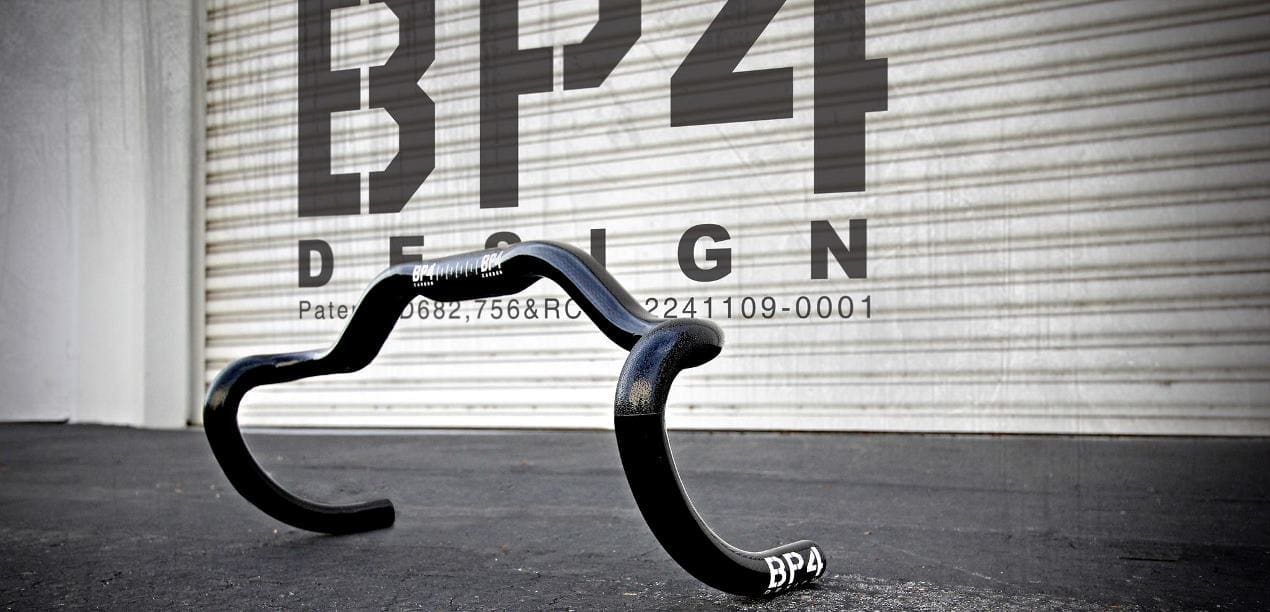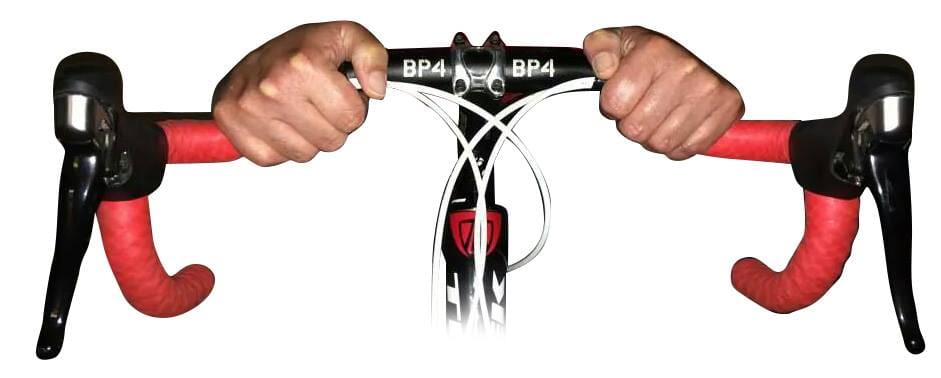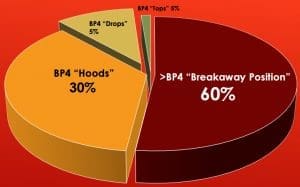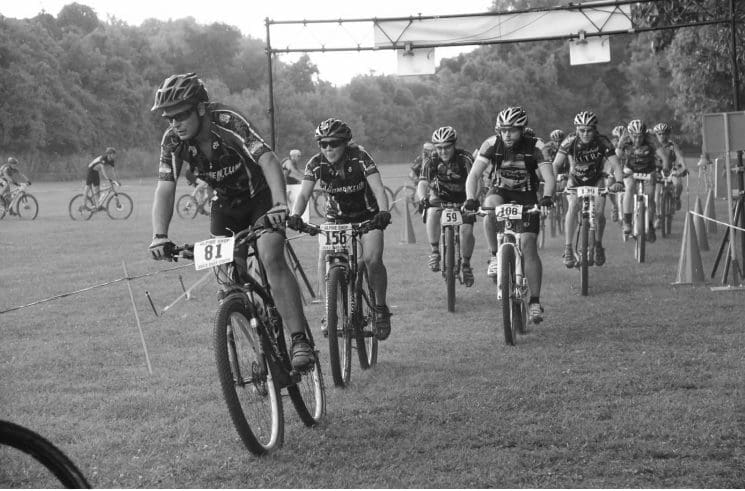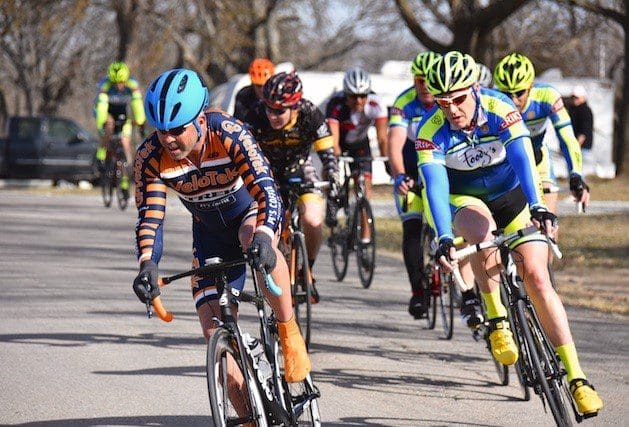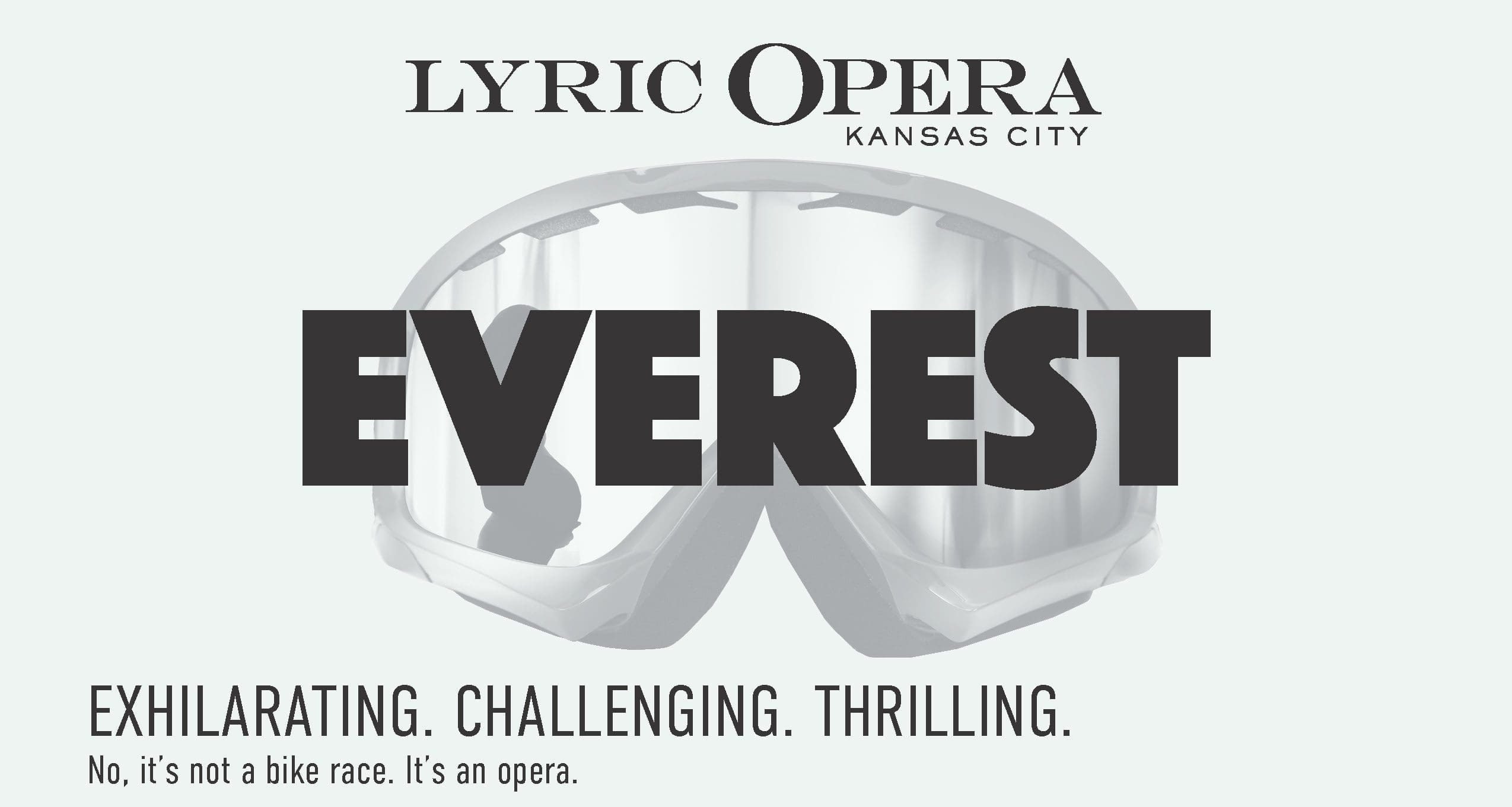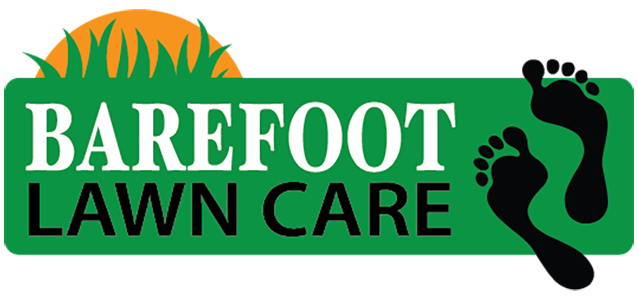A higher power output with less effort, that is the claim that BP4 Design makes about their BP4 handlebar. Cyclists are always seeking ways to gain an advantage over their competitors; a handle bar that promises a faster ride is worth a hard look.
In the company’s own words, “The BP4 Design is the first and only patented wind tunnel & lab tested road drop handlebar in the world, proven to elevate rider performance. The patented BP4 handlebar position allows the rider to be biomechanically and ergonomically optimized, resulting in superior aerodynamics, enhanced comfort, increased power and greater VO2 efficiency.”
The key to the BP4 handlebar is in the unique design and what they refer to as the “breakaway position”. The BP4 takes the normal road bar design and adds a bend about halfway between the stem and the drops that brings the handlebars down about 5cm. This bend creates an angled section you can grip that is somewhat similar in feel to time trial bar extensions.
Specifications
The BP4 bars are made with T-700 carbon fiber. They are available in 42 or 44cm widths measured center to center. The stem and brake lever mounting areas have a textured, non-slip grit surface to help prevent slippage. Cable grooves located along each side allow the cables to all but disappear once bar tape is applied. The bars have a 77mm reach with a 179 drop. The BP4 angle drops the hoods 54mm. The center of the bar is 31.8mm and the 44cm bar comes in at 285 grams. They are not aero bar compatible.
Wind Tunnel Testing
BP4 has done extensive testing at the FASTER Speed Lab in Scottsdale, Arizona. For the testing sessions, the hoods of the BP4 bars were set up in each test to be even with the standard bar hoods, To achieve this FASTER Lab included a 17 degree stem with BP4 test to offset the 5cm drop. [pullquote cite=”Rich LaPorte” type=”right”]In a nutshell, the BP4 position is more “aero” than the tops, hoods, and drops because the rider’s frontal area is narrower, but the breathing and power output is more efficient because the rider is more upright and biomechanically correct.[/pullquote]
The testing came up with some impressive numbers. The BP4 position vs. the tops shows the average drag time savings was 51 seconds over 40k. Comparing the BP4 position vs. the hoods, the average drag time savings was 26 seconds over 40k and 52 seconds at a direct headwind of 0-5 degrees.
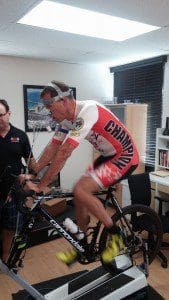 The BP4 position vs. drops the average drag time savings was 20.4 seconds over 40k but the rider’s Zephyr data showed an average of 185 watts in the drops which was 20 watts less vs. the 205 watts put out by the rider in the BP4 Position. The lower power production in the drop position equates to a .5 mph slower average over 40k or 2 minutes gained in the BP4 position. So, when compared to the drop position, the data shows the rider saving 20.4 seconds from decreased drag plus 2 minutes of savings based on an increased power output.
The BP4 position vs. drops the average drag time savings was 20.4 seconds over 40k but the rider’s Zephyr data showed an average of 185 watts in the drops which was 20 watts less vs. the 205 watts put out by the rider in the BP4 Position. The lower power production in the drop position equates to a .5 mph slower average over 40k or 2 minutes gained in the BP4 position. So, when compared to the drop position, the data shows the rider saving 20.4 seconds from decreased drag plus 2 minutes of savings based on an increased power output.
The velodrome produced more time savings over 40k. Their testing showed 101 seconds saved over the drops and 71 seconds over the hoods when in the BP4 position.
These times savings seem small but really are significant, roughly equivalent to time saved with a deep dish wheel set or an aero time trial helmet.
BP4’s Rich LaPorte discussed the data, “They were a little perplexed at the wind tunnel/lab with these findings, the subjects breath rate was 10 breaths per minute more in the “Drops” and producing 20 watts less of power. We feel the wind tunnel and the velodrome data was very favorable to our BP4 position concerning wind drag but the biggest breakthroughs will be in power output and breathing efficiency saving many minutes, studies are currently ongoing with these. In a nutshell, the BP4 position is more “aero” than the tops, hoods, and drops because the rider’s frontal area is narrower, but the breathing and power output is more efficient because the rider is more upright and bio-mechanically correct.”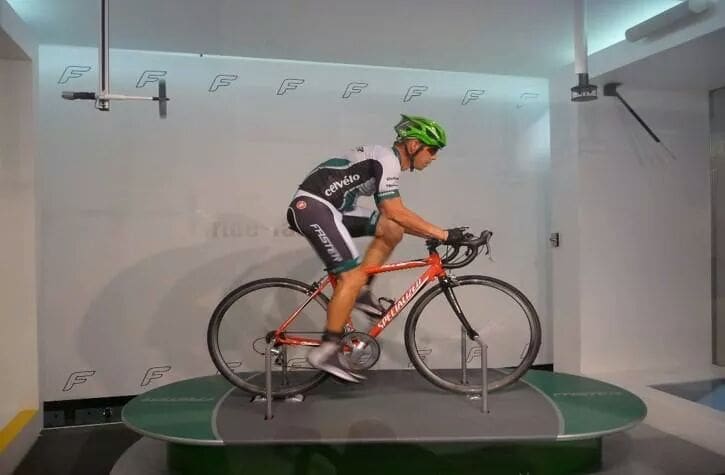
According to their testing, riders are not only more aerodynamic when utilizing the BP4 position, they are creating more power at a lower breath rate. In other words, riders are faster with less effort.
You can take a look at their White Paper to view their data and findings.
Installation
BP4 does suggest a longer stem might give riders a better fit when switching to the BP4 bars. During our test riding it did indeed feel like we needed another 10mm in length out of our stem. We would suggest riding the bars with your current stem and then adjusting your position with a longer stem if you feel it necessary after a few rides.
You have a couple of options when installing the bars. Those looking for the most out of the bars can opt to simply mount the bars on your current set-up with no changes. This will drop your front-end by 54mm giving you a very aggressive position on the bike. If you are looking to match the BP4 hood height to your standard bar set-up then you can get a +8 to +17 degree stem to negate the 54mm drop with the BP4.
We chose to mount the BP4 on the bike without changing the stem height in order to take full advantage of the aggressive position offered by the 5cm drop brought about by the unique design of these bars.
Comfort
Based on rider feedback, BP4 states that riders are more comfortable in the breakaway position and are therefore spending a majority of their time riding with their hands on the breakaway bend. Based on rider feedback, riders are spending 60% of their time riding in this position. Riders reported spending 80% of their time riding on the hoods on their traditional bars.
When riding, the breakaway position was very comfortable to use and the additional grip options came in handy on long rides.
- Rider self-estimated time spent in each position on a traditional bar.
- Rider self-estimated time spent in each position on the BP4 bar.
On the Road
It took a few miles to get used to the BP4 handlebar but it was easy to adapt to during the first ride with the bars. The carbon bars give a great road feel on the bike and are plenty stiff. The design gave extra hand placement options that we really enjoyed, especially on longer rides.
Anecdotally, the bike definitely feels faster with he bars on. While we don’t have a wind tunnel and expensive equipment to crunch the numbers, we felt the position achieved with these bars created a faster overall ride. The difference was especially felt faster in three situations:
Descending
The breakaway position was awesome for descending, it is fast and compact. When descending on standard road bars with hands placed on the tops, close the the stem, the elbows tend to stick out away from the body so you have to draw them in and hold them against your sides. When using the breakaway position for descending, the elbows naturally fold in, like a praying mantis. It is much easier and more comfortable to hold the aero-tuck position and the slightly lower hand-hold creates a bit more aggressive position on the bike gaining another slight aero advantage.
Breakaway/Chase
The deep drop achieved by installing these bars provided a clear boost to both chase and breakaway efforts. Whether utilizing the breakaway position, the hoods, or the drops, the 54 mm drop on the front end made a noticeable difference when chasing down a rider.
Sprinting
Sprinters who can get low during their sprint have a huge aerodynamic advantage. The 5cm BP4 drop allows you to get low, really low, when sprinting in your drops. Since air resistance increases exponentially with speed, a fast sprinter can gain a valuable advantage with a lower body position during a high-speed finish.
Conclusion
Riders who like an aggressive position and are flexible enough, will enjoy the benefit of a more aero position. The 54mm drop achieved when swapping a standard road bar with the BP4 may be a little too much for some riders. Those riders wanting to take advantage of the breakaway position and the additional grip placement options of the BP4, but do not wish to have such an aggressive drop, can raise their stack height, install a +8 to +17 degree stem, or a combination of the two in order to have the BP4 approximate their standard road bar position.
Those who do take advantage of the lower position and BP4 breakaway position will be treated to an aggressive ride and more grip placement options.
At 240 grams they are not the lightest carbon bars out there but the extra length of material needed to create the 54mm BP4 angle must be taken into account. That being said, they are a nice, relative light set of bars that are stiff enough to handle some serious sprint efforts without much flex.
At $295 these bars are in-line with other carbon bars but the dollars to performance factor is huge when taking the time savings data into account. Assuming the data is accurate, you are talking under $300 for significant time savings; when compared to a set of deep-dish carbon wheels that can run into the thousands of dollars, these bars could potentially provide a cost/benefit ratio that exceeds that of carbon wheels.
The test data provided by BP4 is impressive. However, the sample size is small which means the additional testing will be very important. That being said, our real world riding seems to support a faster ride when using the BP4. This is due in part to the lower, more aggressive position but the data does seem to support a more efficient ride when using the BP4 angle regardless of the height of the bar. It is very possible that BP4 has built a better mousetrap. They are after all, after 5 months, still on our bike.

